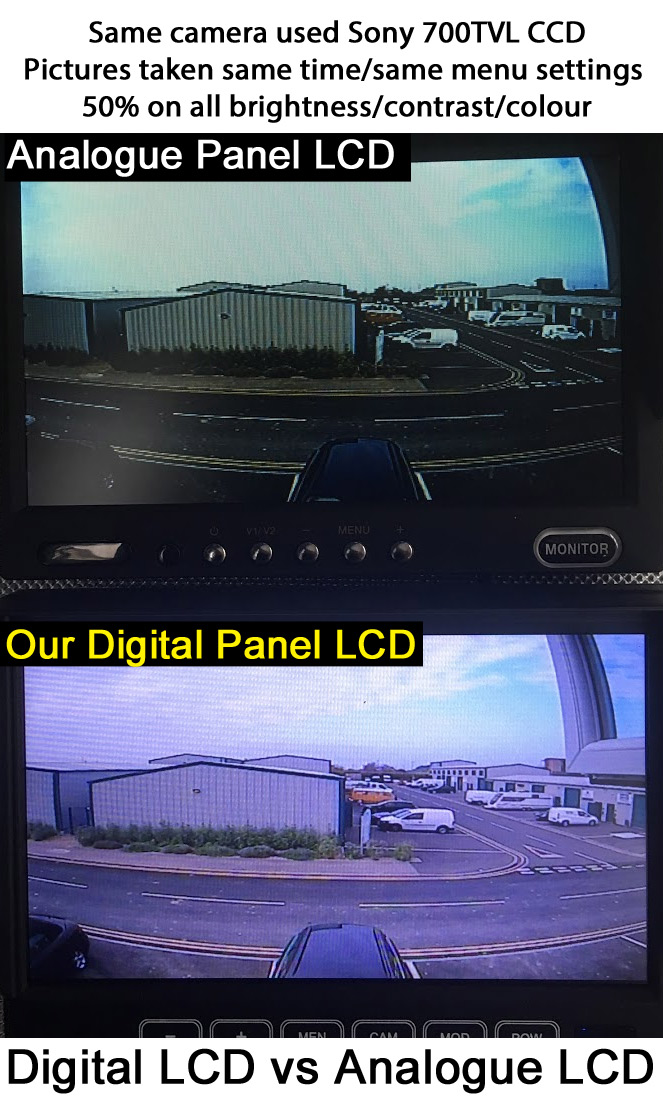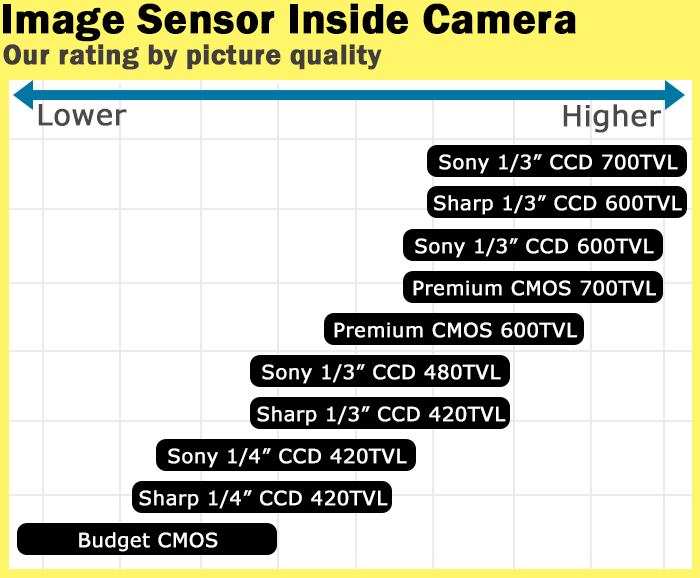Camera Kit Guidance
Buying a reversing camera kit can be a confusing task, you want the best but aren't sure what to look for to ensure you get the best. In our premium kits category we only stock the highest spec items, so they will always have the best digital LCD panels and the highest spec image sensors (the bit that captures what the camera sees and turns it in to a signal for the screen). What is the difference between Digital LCD and the normal (analogue) LCD I see others sell?The difference is vast, a decent camera put through an analogue panel screen won't be used to anywhere near it's full potential. The thing that confuses people is the fact they look identical to each other, analogue panels are the same size, colour, look and feel. It's only when you see them running side by side do you see the big difference. The digital panels are sharper/crisp and replicate the colours much better. Our 7" Digital LCD panels are running 800x480 pixels compared to the equivalent "normal" analogue panel which runs 480x234. That means our panels hold more than three times the number of pixels in the same area meaning a much crisper picture. Top tip When looking around at other retailers you may notice they display the first figure higher (1440x234), this is 480x3=1440, the 3 refers to RGB (as a pixel is made up of 3 colours). Ours could be displayed as 2400x480 but we prefer to keep it simple and display it as 800x480 as this is more useful to people.
The pic above has some slight interlacing which comes from taking a picture of a screen as it rapidly refreshes at around 50 times a second, you don't see it in real world conditions, just when you try taking photos of tv screens with a camera. I keep seeing CMOS and CCD mentioned, which is best?Short and simple answer is CCD tends to be best at present. There are a few very new generation CMOS image sensors running at around 600TVL, but they are as expensive as the CCD image sensors. 99% of the CMOS you will see advertised elsewhere are the cheaper, poorer quality image type typically made by companies Omnivison and Pixel Plus (Omnivision chip sets start OV and Pixel Plus starts PC). Our premium kits use CCD image sensors, to add to the confusion there are different qualitys of CCD image sensor. The best at the moment being the Sony Effio 700TVL, which is widely respected as being the best out there in terms of day and night picture quality. Below is a guide to the image sensors, it tends to be that the 1/4" Sharp is the lower end of CCD and it gradually improves as you move up to 1/3" image sensors and then you start to see the TV lines increase on these. 1/3" image sensors have a larger surface area than the 1/4" image sensors.
Which monitor should I choose?We have a selection of monitors to choose from depending on where you wanted to mount it and what type of vehicle it is being mounted on. We stock 2x 5" monitors, 2x7" monitors and 1x7" clip over mirror monitor. The picture quality is similar between all the different monitors. Which camera is best for my needs?You will notice that the Kit numbers have at least two numbers and sometimes a letter, for example the KIT PM31W. This means that the kit belongs to the PM30 series monitor, the camera used is choice 1W (W is for white). Below you can see brief descriptions of the camera options. PM*1 A staple of our range, very popular with HGV, vans and agriculture, very capable camera with the maximum number of IR led's for great night vision. Camera used in these kits is the CAM022. PM*1W The white version of the above camera, CAM061, this was in the past the most popular camera for motorhomes (this has since changed to the twin lens), but still a staple of van drivers and caravans. PM*2 Two camera kit using two of the CAM022's, with two separate cameras so they can be mounted in two separate areas, popular on farm machinery and in horseboxes. PM*2W Two camera kit, as above but using the CAM061's in white. PM*3 The black version of our twin lens, twin lens being one of the most popular cameras due to having a wide angle for looking down around the bumper and a narrow angle for looking down the road (narrow being best as a rear view always on camera) PM*3W The white version of our twin lens, twin lens being one of the most popular cameras due to having a wide angle for looking down around the bumper and a narrow angle for looking down the road (narrow being best as a rear view always on camera) PM*4 The flush mounted bumper camera option, uses our CAM038, it has a mechanical seal to ensure no water ingress, it runs cool due to the 700TVL effio (older 1/3" ran warm which meant you couldn't keep them on for long). These cameras are subtle and popular on cars and any location with a flat area of around 30mm. PM*5 The latest generation of number plate camera, and the only number plate camera we would place in our premium range. This has just been upgraded to be even better still with the Sharp 600TVL 1/3" image sensor (when we first started selling these they used the Sharp 1/4" as the 480TVL Sharp 1/3" wouldn't fit with the support boards). PM*6 This is the black compact version of the bracket camera, it uses the same image sensor as the larger version but comes in a smaller size. There are a few less IR led's but not so much to make too much difference on night vision. PM*6W This is the white compact version of the bracket camera, it uses the same image sensor as the larger version but comes in a smaller size. There are a few less IR led's but not so much to make too much difference on night vision. PM*7 This is a roof mounted camera, very popular with Mercedes sprinter customers and similar vans. Again this has been updated, as originally the ball cameras couldn't fit the 1/3" Sharp image sensor support boards, so these were originally 420TVL 1/4" Sharp CCD, now they are running 600TVL 1/3" Sharp CCD image sensors. Beautiful image quality. PM*7W This is the white roof mounted camera, very popular with Mercedes sprinter customers and similar vans. Again this has been updated, as originally the ball cameras couldn't fit the 1/3" Sharp image sensor support boards, so these were originally 420TVL 1/4" Sharp CCD, now they are running 600TVL 1/3" Sharp CCD image sensors. Beautiful image quality. PM*8 You may recognise this camera if you have seen certain branded systems priced at around triple the amount, We can't mention names, but they are on of the biggest/dearest brands. The reason it looks similar is because it is made by the same factory they use. Polished stainless steel bracket makes it look pretty impressive. It is usually bought as a kit by people wanting a commercial grade system. PM*9DB This uses the slightly older generation 1/3" 480TVL Sharp CCD, still a decent image. Dome camera that also looks a little like a CCTV camera, which puts off would be thieves. Van owners and a few motorhome owners are our main customers for these. PM*9DW This uses the slightly older generation 1/3" 480TVL Sharp CCD, still a decent image. Dome camera that also looks a little like a CCTV camera, which puts off would be thieves. Van owners and a few motorhome owners are our main customers for these. What cable length should I select?Rough guide: 5M is good for a car 10M is good for a medium length van (around 6M) 12.5M is good for most vehicles up to around 8.5M long (covers most motorhomes except the super long) 15M is good for vehicles up to around 10/11M eg rigid lorry, small coach. 20M is good for super long vehicles Trailer Link is ideal when you are placing the camera on a trailer Pre-fitted adaptors (for if you have a 2010 onwards motorhome with the new 6 pin screw cable shown in listing)
|






